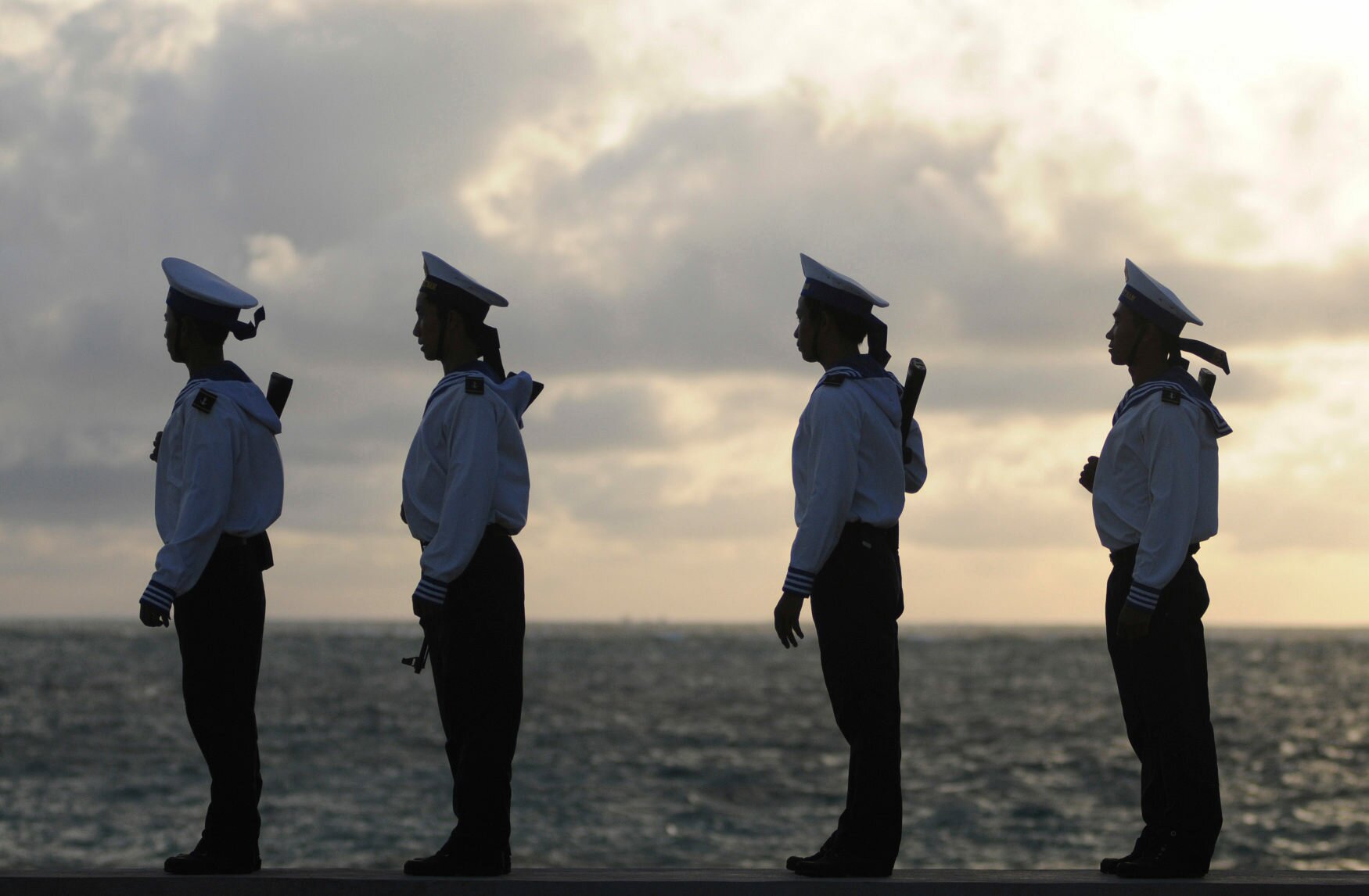 Territorial Disputes in the South China Sea
Territorial Disputes in the South China Sea
- Browse All conflicts
- Region Asia & Pacific
- Impact on U.S. Interests Critical
- Conflict Status Worsening
- Type of Conflict Territorial Dispute
- 11 billion Estimated barrels of oil in the South China Sea
- 190 trillion Estimated number of cubic feet of natural gas in the South China Sea
- $5.3 trillion Total annual trade passing through the South China Sea
Recent Developments
Territorial and jurisdictional disputes in the South China Sea continue to strain relationships between China and other countries in Southeast Asia, risking escalation into a military clash. The United States has sought to uphold freedom of navigation and support other nations in Southeast Asia that have been affected by China’s assertive territorial claims and land reclamation efforts. In the fall of 2015, the United States signaled that it will challenge China’s assertion of sovereignty over disputed territory by flying military aircraft and deploying ships near some of the islands.
In recent years, satellite imagery has shown China’s increased efforts to reclaim land in the South China Sea by physically increasing the size of islands or creating altogether new islands. In addition to piling sand onto existing reefs, China has constructed ports, military installations, and airstrips—particularly in the Spratly Islands.
Background
China’s sweeping claims to sovereignty over the sea—and the sea’s alleged 11 billion barrels of untapped oil and 190 trillion cubic feet of natural gas—have antagonized competing claimants Malaysia, Vietnam, Brunei, Taiwan, Indonesia, and the Philippines. As early as the 1970s, countries began to claim islands and various zones like as the Spratly islands, which may possess natural resources and rich fishing areas, in the South China Sea as their own.
China maintains that under international law, foreign militaries are not able to conduct intelligence gathering activities, such as reconnaissance flights, in its exclusive economic zone (EEZ). According to the United States, countries should have freedom of navigation through EEZs in the sea and are not required to notify claimants of military activities. China’s claims threaten sea lines of communication, which are important maritime passages that facilitate trade and the movement of naval forces.
In recent years, China has built three airstrips on the Spratly Islands to extend its presence in disputed waters. China has warned its Southeast Asian neighbors against drilling for oil and gas in the contested region, disrupting other nations’ oil exploration and seismic survey activities. To challenge China’s claims in international waters, the United States has deployed destroyer ships on missions in the South China Sea. Currently, the Permanent Court of Arbitration in The Hague is hearing a claim brought by the Philippines against China, although Beijing refuses to accept the court’s authority.
Concerns
The United States, which maintains important interests in ensuring freedom of navigation and securing sea lines of communication, has expressed support for an agreement on a binding code of conduct and other confidence-building measures. The United States has a role in preventing military escalation resulting from the territorial dispute. However, Washington’s defense treaty with Manila could draw the United States into a China-Philippines conflict over the substantial natural gas deposits in the disputed Reed Bank or the lucrative fishing grounds of the Scarborough Shoal. A dispute between China and Vietnam over territorial claims could also threaten the military and commercial interests of the United States. The failure of Chinese and Southeast Asian leaders to resolve the disputes by diplomatic means could undermine international laws governing maritime disputes and encourage destabilizing arms buildups.
Alerts
Air Force to Keep Flying Over South China Sea
March 8, 2016
The U.S. Air Force will continue to fly daily missions over the South China Sea. Despite a buildup of Chinese surface-to-air missiles and fighter jets in the contested region, both nations’ militaries continue discussions to avoid any “miscalculation.” The United States also urges other nations to exercise their freedom to fly and sail in international airspace and waters claimed by China in the South China Sea” or risk losing it throughout the region” (NYT).
Philippines Accuses China of Blocking Its Waters
March 2, 2016
China deployed as many as seven naval vessels to an area of the South China Sea near the contested Spratly Islands, blocking local fisherman from their traditional routes, according to Philippine officials (Reuters). On Tuesday, U.S. Defense Secretary Ashton Carter warned China that there would be “specific consequences” to aggressive behavior in the region.
Philippines Asks China to Respect Sea Dispute Arbitration
March 1, 2016
The Philippines on Monday urged China to respect a forthcoming ruling by an arbitration court in The Hague on a territorial dispute in the South China Sea after Beijing accused Manila of “political provocation.” China refuses to recognize the case lodged by the Philippines with the tribunal and says all disputes should be resolved through bilateral talks (Reuters).
China Deployed Missiles in South China Sea
February 17, 2016
Beijing has placed surface-to-air missiles on Woody Island, a disputed island in the South China Sea (WSJ).
A Visual Exploration of the Conflict
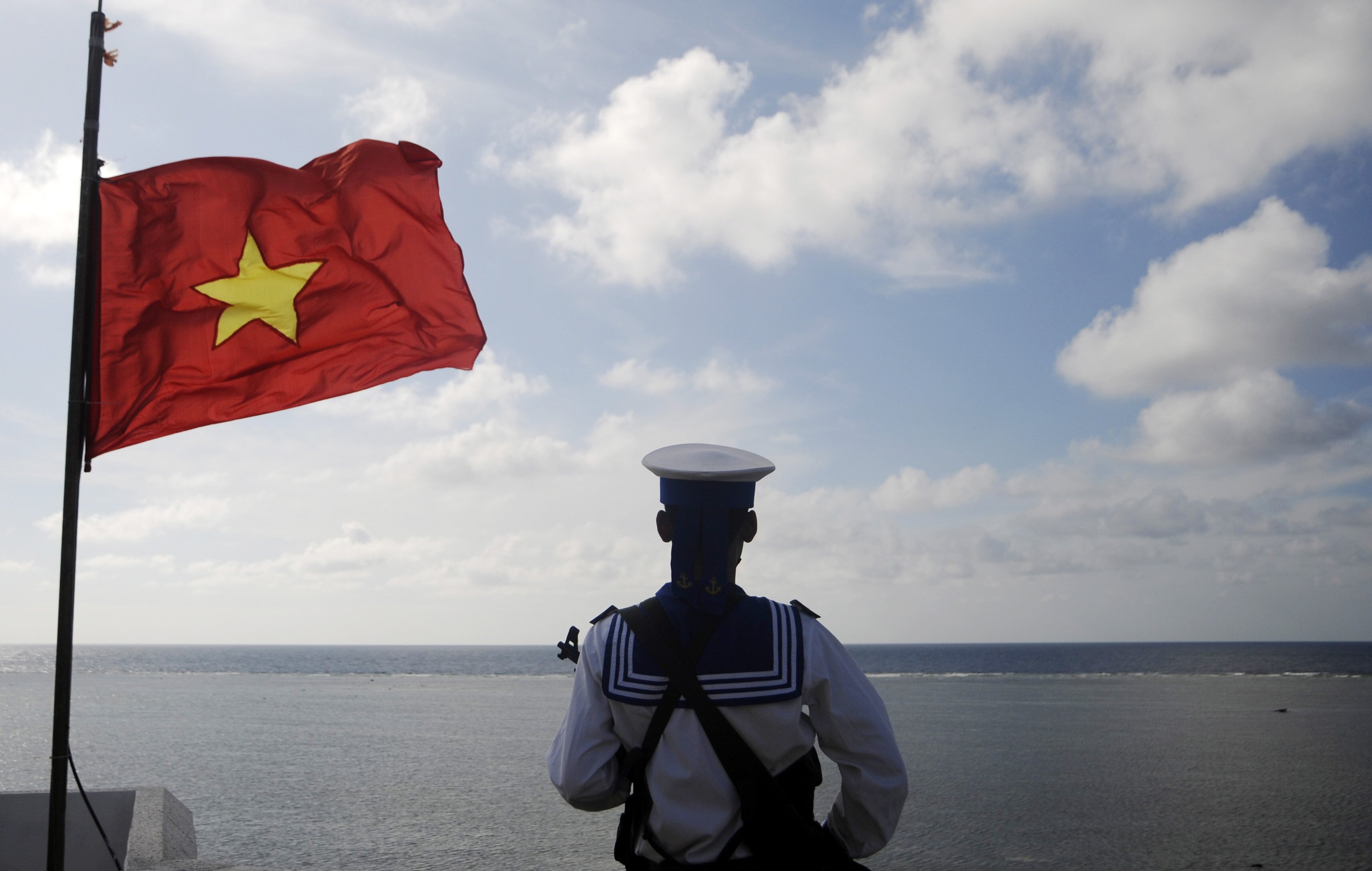 A Vietnamese naval soldier stands quard at Thuyen Chai island in the Spratly archipelago January 17, 2013. (Quang Le/Reuters)
A Vietnamese naval soldier stands quard at Thuyen Chai island in the Spratly archipelago January 17, 2013. (Quang Le/Reuters) 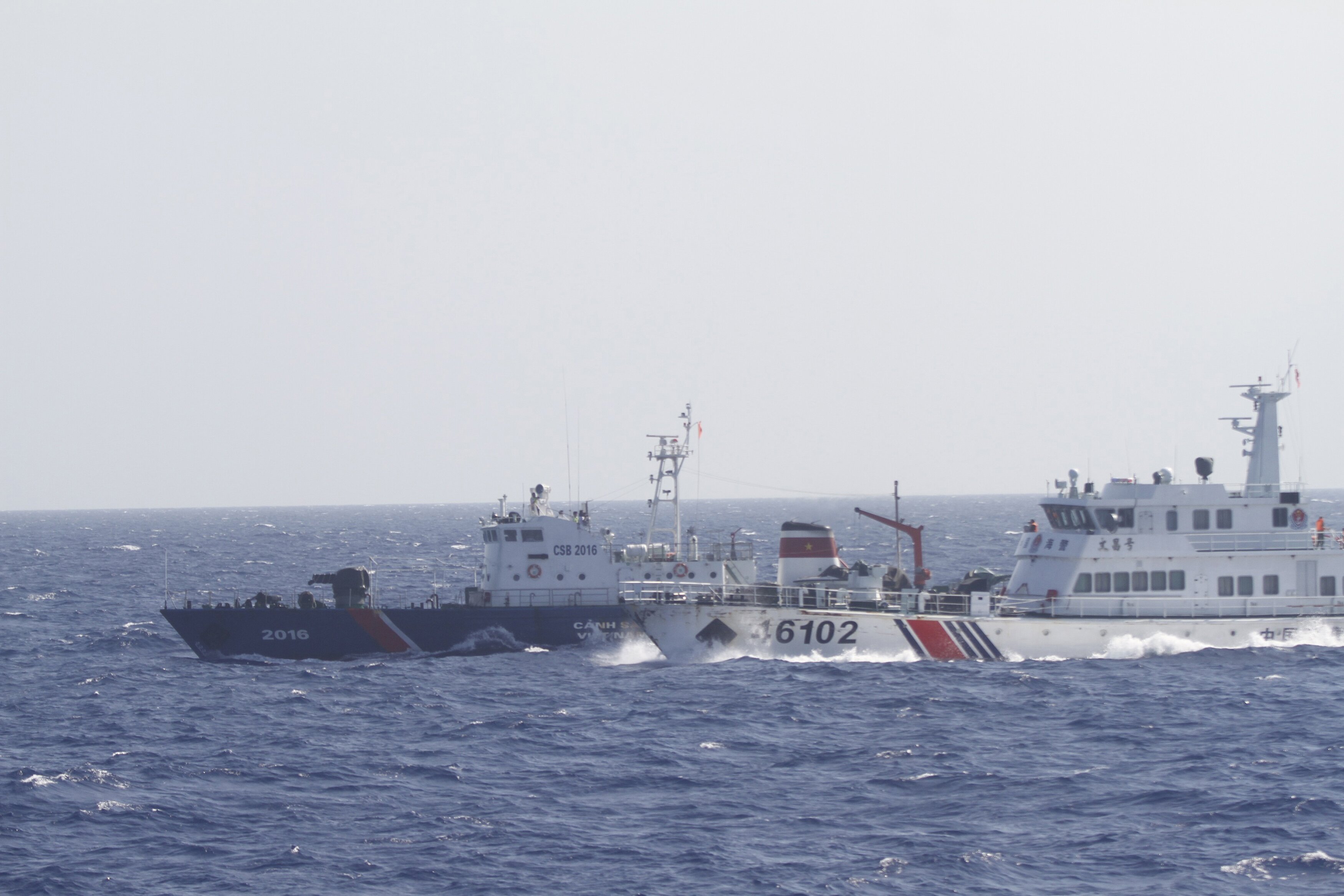 A ship of Chinese Coast Guard is seen near a ship of Vietnam Marine Guard in the South China Sea, about 210 km (130 miles) off shore of Vietnam on May 14, 2014. (Nguyen Ha Minh/Reuters)
A ship of Chinese Coast Guard is seen near a ship of Vietnam Marine Guard in the South China Sea, about 210 km (130 miles) off shore of Vietnam on May 14, 2014. (Nguyen Ha Minh/Reuters) 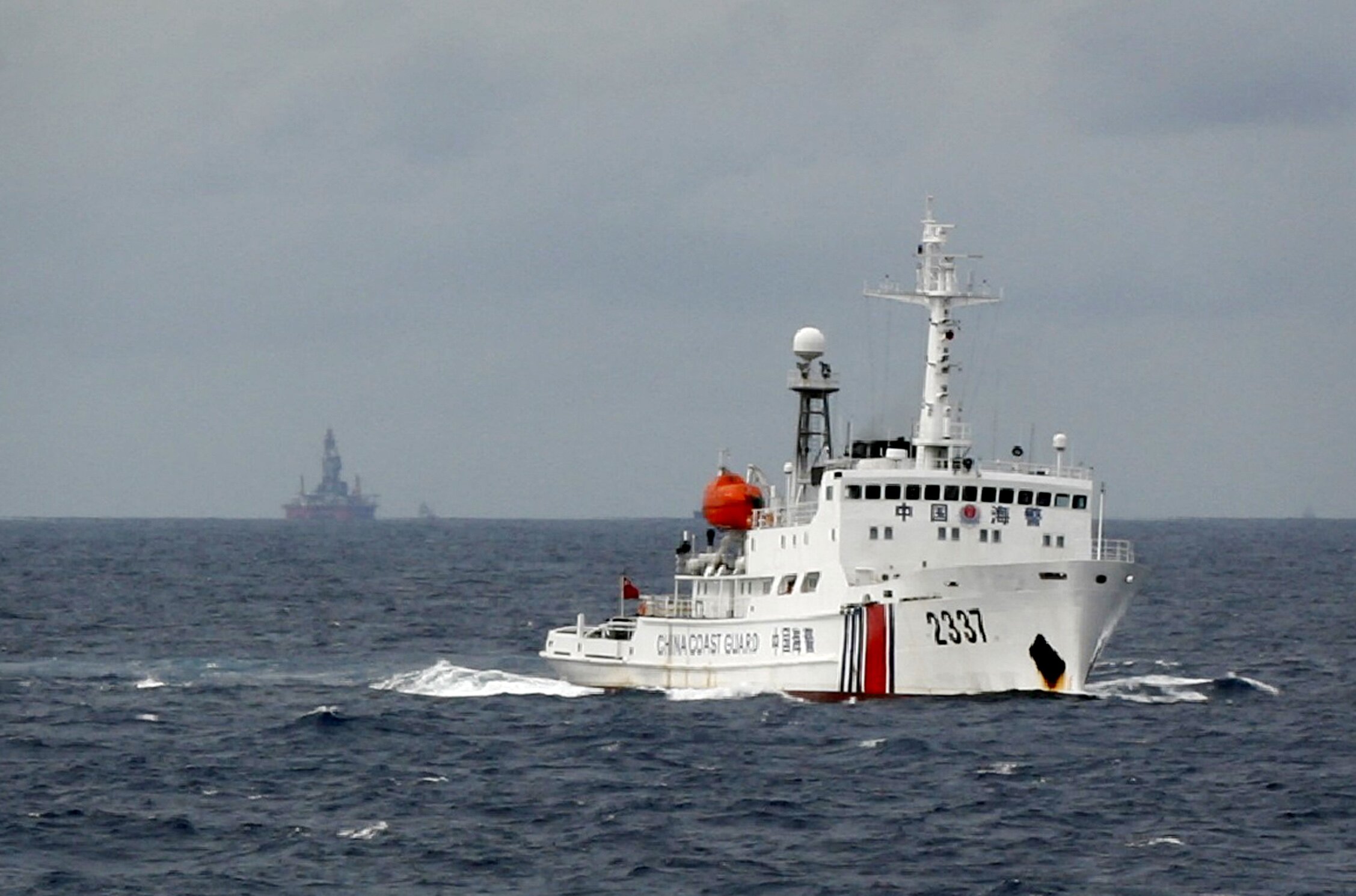 A Chinese Coast Guard vessel passes near the Chinese oil rig, Haiyang Shi You 981 in the South China Sea, about 210 km (130 miles) from the coast of Vietnam on June 13, 2014. (Nguyen Minh/Reuters)
A Chinese Coast Guard vessel passes near the Chinese oil rig, Haiyang Shi You 981 in the South China Sea, about 210 km (130 miles) from the coast of Vietnam on June 13, 2014. (Nguyen Minh/Reuters) 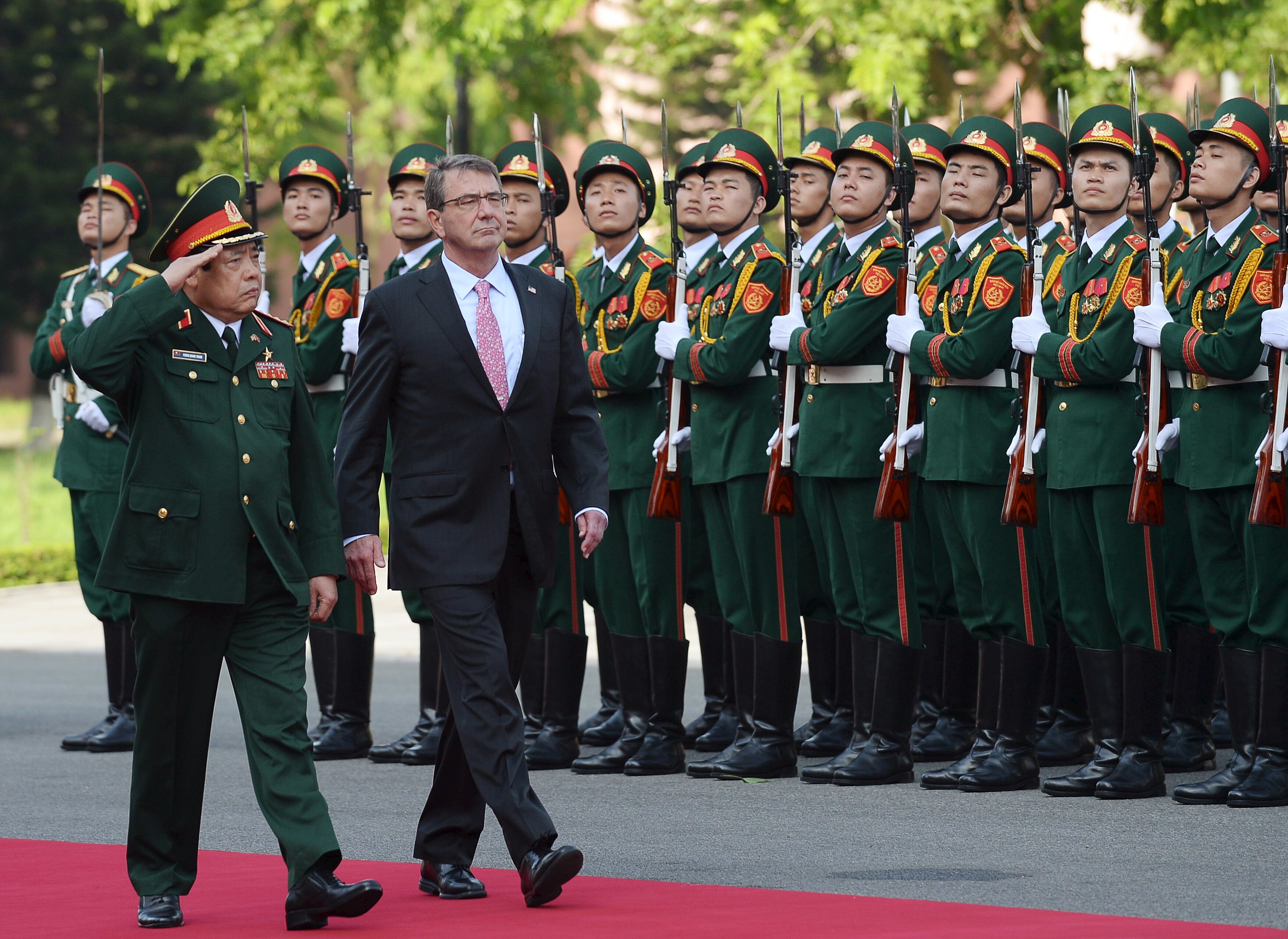 U.S. Defense Secretary Ash Carter and Vietnam’s Defense Minister Phung Quang Thanh review the guard of honour during a welcoming ceremony at the Defense Ministry in Hanoi, Vietnam, on June 1, 2015. (Hoang Dinh Nam/Pool/Reuters)
U.S. Defense Secretary Ash Carter and Vietnam’s Defense Minister Phung Quang Thanh review the guard of honour during a welcoming ceremony at the Defense Ministry in Hanoi, Vietnam, on June 1, 2015. (Hoang Dinh Nam/Pool/Reuters)  Chinese naval soldiers stand guard on China’s first aircraft carrier Liaoning, as it travels towards a military base in Sanya, Hainan province, in this undated picture made available on November 30, 2013. (Stringer/Reuters)
Chinese naval soldiers stand guard on China’s first aircraft carrier Liaoning, as it travels towards a military base in Sanya, Hainan province, in this undated picture made available on November 30, 2013. (Stringer/Reuters)
Background Information
South China Sea dispute rolls on with no resolution in sight
Mark Valencia, South China Morning Post
April 9, 2014
When is a Rock Not a Rock?
Keith Johnson, Foreign Policy
April 4, 2014
Banyan: The pressure on the Sierra Madre
Economist
March 22, 2014
Forget Oil and Gas, the South China Sea Just Got More Complicated
Nicolas Jenny, International Policy Digest
March 18, 2014
Getting Tough in the South China Sea
Robert Haddick, The National Interest
February 25, 2014
For South China Sea claimants, a legal venue to battle China
Greg Torode, Reuters
February 12, 2014
The U.S. and China’s Nine-Dash Line: Ending the Ambiguity
Jeffrey A. Bader, Brookings Institution
February 6, 2014
Avert Conflict in the South and East China Seas
Jonathan D. Pollack, Richard C. Bush III and Bruce Jones, Brookings Institution
January 23, 2014
China Ascendant: Is Conflict Inevitable?
Rajan Menon, The National Interest
December 17, 2013
A Game of Shark and Minnow
Jeff Himmelman, New York Times Magazine
October 25, 2013
Primary Sources
Assistant Secretary Russel’s Congressional Testimony on Maritime Disputes in East Asia
U.S. Department of State
February 5, 2014
Air Force Technical Director Fuell’s Congressional Testimony: “Broad Trends in Chinese Air Force and Missile Modernization”
U.S.-China Economic and Security Review Commission
January 30, 2014
Joint Press Availability With Vietnamese Deputy Prime Minister and Foreign Minister Pham Binh Minh
U.S. Department of State
December 16, 2013
South China Sea
U.S. Energy Administration
February 7, 2013
Latest CFR Analysis
China’s Maritime Disputes
CFR.org InfoGuide
South China Sea Tensions
Beina Xu, CFR.org Backgrounder
China and Southeast Asia: Take Three
Elizabeth C. Economy, CFR.org blog “Asia Unbound”
October 1, 2013
China’s Maritime Disputes: Are There Any Real Solutions?
Joshua Kurlantzick, CFR.org blog “Asia Unbound”
September 17, 2013
Armed Clash in the South China Sea
Bonnie S. Glaser, CFR Contingency Planning Memorandum
April 2012
Related CFR Experts
Elizabeth C. Economy
C.V. Starr Senior Fellow and Director for Asia Studies
Joshua Kurlantzick
Senior Fellow for Southeast Asia




